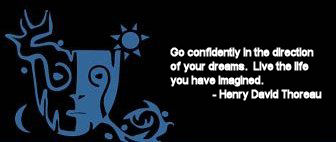|

Marriage
and the
Four Functions of Myth
© 2007 Donny Palmgren
 At the time I'm writing this, my wedding is just weeks away. On May, 5th my lovely fiancée, Judi, and I are getting married in a state park nestled at the foot of a mountain, right beside a river in a ceremony we are writing entirely ourselves. Well... technically we will be getting married at the local courthouse on some yet-to-be determined date, where we'll get legally signed-off by some clerk... but as far as we're concerned, we are getting married in a park, by a river, on May, 5th. A marriage, for us, isn't just a change in legal status... but what, then, does it mean to get married? At the time I'm writing this, my wedding is just weeks away. On May, 5th my lovely fiancée, Judi, and I are getting married in a state park nestled at the foot of a mountain, right beside a river in a ceremony we are writing entirely ourselves. Well... technically we will be getting married at the local courthouse on some yet-to-be determined date, where we'll get legally signed-off by some clerk... but as far as we're concerned, we are getting married in a park, by a river, on May, 5th. A marriage, for us, isn't just a change in legal status... but what, then, does it mean to get married?
Obviously, for most people, beyond the legal change, there's a change in "religious status." But one reason why Judi and I are going to be in a park acting-out a ceremony we have authored is because neither of us are part of any organized religious institution (or even a disorganized religious institution, for that matter). My Love is an eclectic-pagan, and I'm more of a philosopher than a True Believer. So, if we're not joining ourselves before a legal institution nor are we joining ourselves before any religious institution, what the heck are we doing... other than coming-up with a perfectly good excuse to have a picnic in May?
Thinking about what marriage means — in general, and to Judi and me in particular — I've found it useful to look at marriage in terms of Joseph Campbell's four functions of myth. I would like our wedding ceremony to touch on each of these ideas.
Where most people define "myth" as something like "stories about gods," (or "other people's religion") Campbell spoke of myth in much, much broader terms. "Myth" as he used it included religion, sacred stories, rituals, dreams, fairytales, modern novels, art, psychotherapy, and theatre. He is sometimes criticized for this broad and apparently inconsistent field of study, but Campbell's approach is quite justifiable because he came up with a functional definition of myth — looking not at what myth is, but what myth does.
Campbell came up with four functions that mythology serves: the mystical, the cosmological, the sociological and the pedagogical. I've taken these and applied them to marriage and the wedding ceremony.
The Mystical Function of Marriage
The mystical dimension of myth is that which unites us with "the Transcendent" — the eternal mystery beyond space, time and the limits of human knowledge. In theistic terms, this is the function of myth that puts us in touch with God. This state of being "in touch" is not simple, rational knowledge, but a deeply felt, mystical experience. In this "original state" the duality of space-time (up/down, before/after) and analytic logic (A/not-A) falls away and "I and the other are One."
In The Power of Myth Campbell says, "What is a marriage? ...It's the reunion of the separated duad. Originally you were one. You are now two in the world, but the recognition of the spiritual identity is what marriage is." Campbell says, "What is a marriage? ...It's the reunion of the separated duad. Originally you were one. You are now two in the world, but the recognition of the spiritual identity is what marriage is."
The concept of the soul mate, that each human being contains only half a soul and somewhere out there is his or her other half, has many sources, but is perhaps best known in Western philosophy from Plato's Symposium. There, the question, 'What is love?' is posed, to which Aristophanes replies with this story: Originally humans were combined of four arms, four legs, and a single head made of two faces, but Zeus feared their power, so he split them all in half, condemning them to spending their lives searching for the other half to complete them.
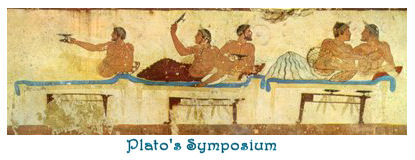
The same story is found in The Zohar, which tells us:
"Each soul and spirit, prior to entering into this world, consists of a male and female united into one being. When it descends on this earth the two parts separate and animate two different bodies. At the time of marriage, the Holy One, blessed be He, who knows all souls and spirits, unites them again as they were before, and they again constitute one body and one soul, forming as it were the right and left of an individual."
The Cosmological Function of Marriage
The cosmological aspect of myth is that which unites us with the rhythms of nature and the cosmos. It presents to us a view of nature that is mythically symbolic and spiritually meaningful.
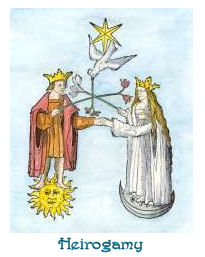 Religious scholar Mircea Eliade is most widely remembered for his theory of "Eternal Return," which holds that rituals and myths do not just imitate or record sacred events that once happened, but, at least to the minds of believers, actually participate in them. In The Myth of the Eternal Return: Cosmos and History (Princeton Classic Editions) Religious scholar Mircea Eliade is most widely remembered for his theory of "Eternal Return," which holds that rituals and myths do not just imitate or record sacred events that once happened, but, at least to the minds of believers, actually participate in them. In The Myth of the Eternal Return: Cosmos and History (Princeton Classic Editions) , he traces marriage rites from cultures all across the globe back to a mythological hierogamy — the divine wedding of the masculine god (usually the sky or sun) and the feminine goddess (the earth or sea). "I am the sky; you are the earth," the Hindu groom says to his bride. This hierogamy is related to fecundity, childbirth and agricultural industry. (Think of rain as the sky father "impregnating" the earth mother.) As a mystical participation with this process, "marital union," wrote Eliade, "is a rite integrated with the cosmic rhythm..." In China, for instance, young couples went out in spring and united on the grass in order to stimulate "cosmic generation" and "universal germination." , he traces marriage rites from cultures all across the globe back to a mythological hierogamy — the divine wedding of the masculine god (usually the sky or sun) and the feminine goddess (the earth or sea). "I am the sky; you are the earth," the Hindu groom says to his bride. This hierogamy is related to fecundity, childbirth and agricultural industry. (Think of rain as the sky father "impregnating" the earth mother.) As a mystical participation with this process, "marital union," wrote Eliade, "is a rite integrated with the cosmic rhythm..." In China, for instance, young couples went out in spring and united on the grass in order to stimulate "cosmic generation" and "universal germination."
Sir James Frazier offers numerous other examples in his classic survey, The Golden Bough , such as: , such as:
"The Oranons of Bengal worship the Earth as a goddess, and annually celebrate her marriage with the sun-god Dharme' at the time when the sal tree is in blossom... The usual form of marriage is performed between the priest and his wife, symbolizing the supposed union between Sun and Earth. After the ceremony all eat and drink and make merry; they dance and sing obscene songs, and finally indulge in the vilest orgies."
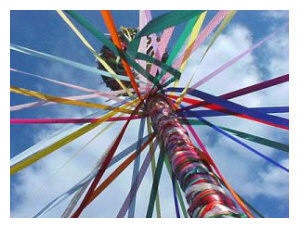 My lovely fiancée and I are getting married the first weekend in May, close to the traditional fertility holidays (or "vilest orgies") of Beltane, Walpurgis Night and May Day. Even though we desire no biological children of our own, we figure a mythically-timely wedding is nonetheless a blessing for health, wealth, enterprise and "spiritual fertility." My lovely fiancée and I are getting married the first weekend in May, close to the traditional fertility holidays (or "vilest orgies") of Beltane, Walpurgis Night and May Day. Even though we desire no biological children of our own, we figure a mythically-timely wedding is nonetheless a blessing for health, wealth, enterprise and "spiritual fertility."
The Sociological Function of Marriage
The sociological (or ethical) dimension of myth is that which unites us with our society, transforming us from mere individuals to constituent, harmonious parts of the group.
The Jewish religion is one of (if not the) most strongly sociologically inflected mythologies in the world. In Judaism, there is no distinction between spiritual enlightenment and legal scholarship. This is reflected in the Hasidic Jewish marriage. These marriages are traditionally arranged between a couple who barely know one-another. 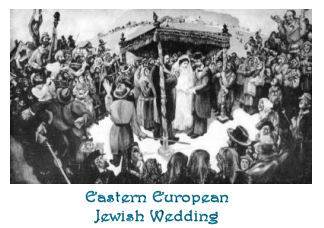 Judaism does not have a monastic tradition; instead it stresses marriage and family life as both a community and religious necessity. The proper behavior one nurtures for one's spouse is out of social and spiritual duty, not love. Love, these folks would say, may ebb and flow... but a marriage built of this socially enforced sense of religious duty is constant. (Shore, "Standing Under the Mountain") Judaism does not have a monastic tradition; instead it stresses marriage and family life as both a community and religious necessity. The proper behavior one nurtures for one's spouse is out of social and spiritual duty, not love. Love, these folks would say, may ebb and flow... but a marriage built of this socially enforced sense of religious duty is constant. (Shore, "Standing Under the Mountain")
The sociological aspect of myth is what lies behind the traditional Christian marriage vows — and what distinguishes a marriage from a love-affair. "I take you... for better or worse, for richer or poorer, in sickness and in health..." "A love affair," says Campbell, "isn't that. That is a relationship for pleasure, and when it gets to be unpleasurable, it's off. But a marriage is a life commitment, and a life commitment means the prime concern of your life." (Power of Myth)
The Pedagogical Function of Marriage
The pedagogical aspect of myth is that which unites us with the psycho-biological arc of a normal human life cycle. It takes us through the transitions we all go though as we grow, mature, age and, finally, die.
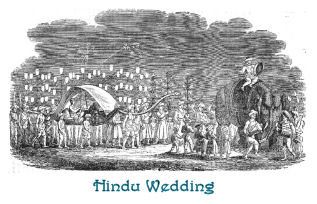 Of the major world religions, Hinduism is one of the best for drawing strong, ritually-enforced distinctions between the normal stages of the life cycle: childhood, youth (i.e. bachelorhood), the householder, and retirement. In Hindu culture, you know exactly where you are. There is a ritual initiation to mark the threshold of each new phase of life... sometimes accompanied by a change of dress, dwelling and even name. The elaborate Hindu wedding ceremony is the initiation rite into the third stage, the householder. (Girish, "The Hindu Brahmin Wedding") Of the major world religions, Hinduism is one of the best for drawing strong, ritually-enforced distinctions between the normal stages of the life cycle: childhood, youth (i.e. bachelorhood), the householder, and retirement. In Hindu culture, you know exactly where you are. There is a ritual initiation to mark the threshold of each new phase of life... sometimes accompanied by a change of dress, dwelling and even name. The elaborate Hindu wedding ceremony is the initiation rite into the third stage, the householder. (Girish, "The Hindu Brahmin Wedding")
Growing up has been a theme for both Judi and me in the two years since we first met... but especially for Judi, of whom I am exceedingly proud. Last year she bought a mostly new wardrobe (less Hot Topic black; more green & earthy and "professional"); we both just moved into a new dwelling in October (after 30 years of living with parents or roommates, we bought what is for both of us our first house); and, of course, she will be changing her last name to mine in a few weeks time (although the legal paperwork will wait until that unspecified courthouse date). She's also quit smoking, exercises more and does volunteer work. I've even caught her voluntarily watching the news!
To quote the great hip-shaking pop-star and sage George Michael as he so poetically put it in one of my favorite songs:
Strange.
Don't you think I'm looking older?
But something good has happened to me.
Change is a stranger
You have yet to know.
Conclusion
To unite my soul, my innermost being, with another, thereby transmuting 'me and you' into 'We'...
To come together in a glen by the river, below a mountain, at the beginning of May in imitation of (or, a True Believer might say, participation with) the Sky and Earth, the Father and Mother...
To ritually initiate a socially (and soon to be legally) enforced vow of fidelity and commitment...
To go through a rite of passage marking the end of our youth and the commencement of our lives as responsible "householders"...
This is what getting married means to me. And I am very much looking forward to it!
Works Cited
- Campbell, Joseph The Power of Myth
 , 1988. (1991 reissue edition from Anchor Books) , 1988. (1991 reissue edition from Anchor Books)
- Eliade, Mircea, The Myth of the Eternal Return: Cosmos and History (Princeton Classic Editions)
 , trans. By William R.Trask, 1954. (Bollingen Series XLVI, excerpt reprinted in Parabola Magazine, V.26, No.1, Spring 2004.) , trans. By William R.Trask, 1954. (Bollingen Series XLVI, excerpt reprinted in Parabola Magazine, V.26, No.1, Spring 2004.)
- Frazier, Sir James, The Golden Bough
 , Vol. I-III, 1890-1915. (1993 Wordsworth Edition.) , Vol. I-III, 1890-1915. (1993 Wordsworth Edition.)
- Girish, Uma, "The Hindu Brahmin Wedding." (Parabola Magazine, V.26, No.1, Spring 2004.)
- Michael, George, "Older," from the album, Older
 , 1996. (Dreamworks.) , 1996. (Dreamworks.)
- Shore, Eliezer, "Standing Under the Mountain." (Parabola Magazine, V.26, No.1, Spring 2004.)
- The Zohar (quoted in Parabola Magazine, V.26, No.1, Spring 2004.)
Donny Palmgren is a high school art teacher, founder of the Charlotte, North Carolina Mythology RoundTable, and member of the Fools Child Comix studio.
Return to Mythic Passages Menu
Subscribe to the Mythic Passages e-zine
|
